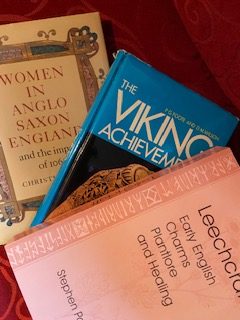New year, a fresh start, and, one of my favourite parts of a new historical novel: the research.
My latest story features an Anglo-Scandinavian woman healer living in 11th century Yorkshire. She is, it seems, perfectly feasible. Certainly, everyday healthcare was the province of women. As for healing people outside the immediate family: it was the Victorians who excluded women from the professions, not the Vikings.
But what might she know? What might she do?
Healers in the 11th century
We have tantalising glimpses of what medical care might have looked like in the 11th century. Practitioners were called ‘leeches’. But it’s a word we don’t like nowadays, so I prefer to call my protagonist a ‘healer’. After all, that’s what she hopes to achieve. There are references to healing activity in stories, law codes, and a few surviving medical texts, all copied by monks.
It’s doubtful that a woman in 11th century Yorkshire would have access to monkish writings. So were the monks writing down knowledge that existed orally? Or were they just copying from libraries that had survived from Roman times?
Thanks to scholar Steven Pollington, I’ve been able to read translations into modern English. And, I would say, some look like treatments that people in Yorkshire could have used. And some, I suspect, are copies of Roman information – particularly those that use plants that thrive in Mediterranean regions, but not Yorkshire.
However, there are other routes that a woman in 11th century Yorkshire might access Roman medical knowledge. Traders and raiders from the Viking world travelled, via what is now Ukraine and Russia, to the Eastern Roman Empire at Constantinople. They would have seen the application of knowledge from the ancient Greek and Roman empires, and brought that knowledge home to Scandinavia.
And as Yorkshire was intimately linked with Scandinavia at that time, the knowledge could have come, by word of mouth, by custom and practice, and by copying procedures – particularly trauma surgeries.
Medical practice in the 11th century
So what did this knowledge look like?
For starters, they did surgeries. Wounds were stitched. Damaged limbs were amputated. Arrows embedded in wounds were removed – there’s an account of woman doing exactly that in the Viking sagas.
Pain, fever, and other symptoms could be treated with herbs. Modern studies have show that some contain substances that are still used in modern times, famously, the aspirin discovered in willow. Some, such as foxglove and henbane, contain powerful substances that can be either medically useful, or highly poisonous, depending on the dose.
Sometimes, Anglo Saxon medical knowledge is mocked, alleging that it is full of superstition and ignorance. Ideas of ‘elf shot’ or ‘worms’ as a cause of disease are considered primitive and superstitious.
But if you substitute ‘virus’, ‘germ’ or ‘infection’ for these invisible forces, it begins to look less different from our own experience of the cause of illness.
However, there’s one remedy recommended by Anglo Saxon medic ‘Bald’ that I would not like to try. For a splinter in the foot, Bald recommends pounding green yarrow with fresh goose turd. Paste it onto the wound, and soon, he claims, ‘all will be well’.
He may be right – but I don’t fancy trying it.
Useful links
Read some Anglo Saxon rememdies online at https://archive.org/details/leechdomswortcun02cock/mode/2up
One of my favourite bloggers on life in Viking times, Viking Answer lady trawls sources to give us readable information. http://www.vikinganswerlady.com/medicine.shtml
Pictures of Roman surgical instruments: an amazing array, not dissimilar to many used today. https://web.archive.org/web/20090918091601/http://www.hsl.virginia.edu:80/historical/artifacts/roman_surgical/
Healthy living Anglo-Saxon style – and some horrific battle injuries. http://www.hurstwic.org/history/articles/daily_living/text/health_and_medicine.htm
Steven Pollington’s informative book about Anglo Saxon ‘Leechcraft’ and herbs. https://www.asbooks.co.uk/t%20Leechcraft.htm

